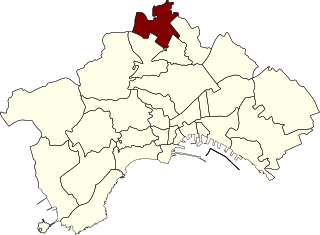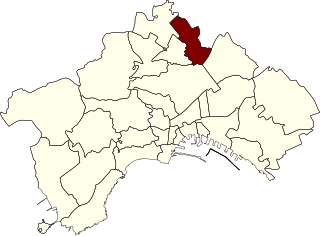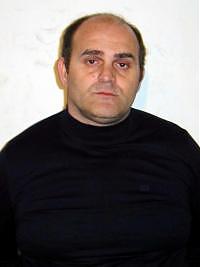
Miano is a suburb of Naples, Italy, with a population of around 26,000. [1]

Miano is a suburb of Naples, Italy, with a population of around 26,000. [1]
Since the recent administrative reorganization of the area, Miano is part of the 7th community board.
It borders to the north with the Scampia district (Cupa Carbone, Via del Gran Paradiso, Via del Cervino, Via Ettore Ciccotti, Via Don Luigi Guanella), to the east with Secondigliano (Via comune Acquarola, Corso Secondigliano, Via Abate Gioacchino, Via Monte Grappa, Via del Sabotino, Cupa called S. Cesarea, Cupa Capodichino, Via Vicinale Vallone di Miano), to the west with the Piscinola neighborhoods (Via Vicinale a Piscinola, Via Vecchia Miano a Piscinola, Via Giorgio Amendola, Via Vittorio Veneto, Via Rocco Marco di Torrepadula, Via Raffaele Marfella) and to the south with the San Carlo all'Arena district.
In the recent reform of the administrative structure of the Municipality, Miano, together with Secondigliano and San Pietro a Patierno, constitutes the VII Municipality of the Municipality of Naples.
To get to Miano, you can take the street of the same name which starts from the roundabout of Capodimonte up to the Secondigliano crossroads. Via Miano is the Park of Bellaria.
The area, though not as notorious as neighbouring Scampìa, has many of the same problems. Unemployment is cited at about 30% to 50%, and there is a strong presence of the Camorra .
The economy is based on the tertiary sector, but until 2005 the large Peroni beer factory was active in Miano, offering work to hundreds of families. After the sale of the company, the plant was closed and awaits the implementation of a major project that aims to create a commercial-recreational center in the former industrial area, completed in 2018. The same situation grips the Villa Russo clinic for the well-known regional crisis that sees the health sector in the foreground.
A problem of the district, as well as of the entire city and province, is the presence of the Camorra which prevents its economic, social and civil take-off especially for young people who are often misled by the organization. [2]
And it is within this problem that a group of people has entered to collaborate, to be present both as operators and as citizens, for the construction and promotion of interventions aimed at the needs of the minors of Miano. The opportunity was seized thanks to the "Granello di Senape" project born a year after the approval of law no. 216/1991 with the aim of offering the teenagers of the neighborhood the opportunity to learn a lawful profession. The project wanted to be a bet on the ability to produce alternatives to organized crime, without denying the social problems that arise but trying to solve them starting from the character resources of the boys. [3]
The “G. Toniolo”, the Don Guanella Opera House and the “Obiettivo Uomo” Cooperative who have made available the premises suitable for the exercise of the professional practice (barman, tailoring, beautician, hairdresser, pizza chef, etc). In addition to training, the project provides for the possibility of carrying out an internship in affiliated companies and the possibility of participating in summer camps for younger children. The success of the project was such that the proposing association became a point of reference for all the territorial agencies that deal with minors at risk: from 1992 to 1997 about 600 young people found work. [3]
Public transport in Miano is entrusted to the bus lines operated by the ANM. The main station in the district is Miano, which operates for Line 1 of the Naples Metro and for the Naples–Aversa railway. Between 1902 and 1960 the city was connected with the center by a special branch of the Capodimonte tramways; between 1913 and 1976 there was also a station along the Alifana railway.
Two stations of Line 1 are under construction in Miano: the first (coming from Piscinola) located in via Miano, the second in via Regina Margherita. The trains of the Arcobaleno line (MCNE) will also stop in both; in this way the district will be directly connected with the city and the province.
A project is envisaged for the construction of a craft citadel, sports facilities, commercial premises and quality housing in the area of the "Caretto" and "Boscariello" barracks, abandoned by the Ministry of Defense and previously designated as land for the new stadium of Napoli Calcio, an intention that was later wrecked. The new Security pole will be built in the Boscariello Barracks, which will house the offices of the State Police including the IV Mobile Department. More than 168 million euros have been allocated by the Conte government for the project. Project confirmed by the Draghi government which also appointed the Extraordinary Commissioner dr. Joseph D'Addato. According to estimates by the State property agency, the structure should be completed and operational by 2024. [4]
{{cite book}}: CS1 maint: others (link)The Camorra is an Italian Mafia-type criminal organization and criminal society originating in the region of Campania. It is one of the oldest and largest criminal organizations in Italy, dating to the 17th century. The Camorra's organizational structure is divided into individual groups also called "clans". Every capo or "boss" is the head of a clan, in which there may be tens or hundreds of affiliates, depending on the clan's power and structure. Consequently, as Camorra clans act independently, they are more prone to feuding among themselves. The Camorra's main businesses are drug trafficking, racketeering, counterfeiting, and money laundering. It is also not unusual for Camorra clans to infiltrate the politics of their respective areas.

Scampia is a modern suburb in the far north of Naples, whose population is about 80,000. To its south are the suburbs of Piscinola-Marianella, Miano and Secondigliano. It was built during the second half of the twentieth century.

Piscinola, or Piscinola-Marianella, is a northern suburb of Naples, Italy, with a population of ca. 20,000. It is bordered to the north by the Scampia district, north-west with the municipality of Mugnano of Naples, on the west by the Chiaiano district, to the south with the district of San Carlo all'Arena and east with the district Miano.

Secondigliano is an old Italian municipality which became a modern suburb in the north of Naples.
The Scampia feud was a feud between the Camorra gangs in the Neapolitan quartiere of Scampia which broke out in 2004 and 2005. The fight was between the Di Lauro clan, from Secondigliano, and the so-called "secessionists", a breakaway faction in the northern suburbs of Naples that tried to assert its control over drugs and prostitution rackets in the area.

Paolo Di Lauro is an Italian crime boss, leader of the Di Lauro Clan, a Camorra crime organization. He is also known as Ciruzzo 'o milionario among other aliases. In 2002 he was included in the list of most wanted fugitives in Italy and was captured in September 2005.
The Di Lauro clan is an Italian crime clan, part of the Camorra in Naples. The clan operates in the neighbourhoods of Secondigliano, Scampìa, Miano, Marianella, Piscinola, and in the adjacent municipalities of Casavatore, Melito, Arzano, Villaricca and Mugnano. At its peak, between the mid-1990s and the early 2000s, the organization was earning more than €500,000 a day from the sale of drugs alone, making Secondigliano the largest open-air drug market in Europe. The founder of the clan is Paolo Di Lauro, from Via Cupa dell'Arco, in Secondigliano.
Vincenzo Licciardi is the boss of the Licciardi clan, and one of the main leaders of the Secondigliano Alliance, a Camorra crime syndicate operating in Naples and the surrounding Campania region. His nickname is 'o Chiatto ("Fatso").
The Lo Russo clan was a Neapolitan Camorra clan operating on its territory within the city of Naples, concentrated specifically in the area of Miano, whose control extended throughout numerous neighborhoods in the north of the city for more than three decades. Since the fall of all the Lo Russo brothers, and the numerous arrests of most of its affiliates, the organization is considered overthrown.
The Licciardi clan is a powerful Neapolitan Camorra clan that operates in the remote areas of Naples, specifically in the Secondigliano district and its stronghold of Masseria Cardone. Its sphere of influence extends to Scampia, Chiaiano, Miano and San Pietro a Patierno.
The Mallardo clan is a Camorra clan operating from the town of Giugliano in Campania, north of the city of Naples. The Mallardo clan is also one of the clans that belongs to the Secondigliano Alliance, that is considered by the authorities as the most powerful Camorra group that is still active.
The Scissionisti di Secondigliano or Amato-Pagano clan is a Camorra clan from the Secondigliano district of Naples, headed by Raffaele Amato and Cesare Pagano. They are also known as "Spagnoli" (Spaniards) because of their strong presence in Spain, particularly in Costa del Sol and Barcelona.

Raffaele Amato is an Italian Camorra boss and head of the Amato-pagano clan, a Camorra clan from Naples. He is known by multiple nicknames in the Neapolitan criminal underworld, including "Lo Spagnolo", "'o Lell", "Lell o' chiatt'" and "'a vecchiarella".

Salvatore Lo Russo is a former member of the Camorra. Officially unemployed, Lo Russo was the head of the powerful Lo Russo clan, a Camorra clan, now defunct, that was based on its territory within the city of Naples, concentrated specifically in its stronghold of Miano. For over 30 years the Lo Russo's organization has extended its influence to numerous neighborhoods in the north of Naples, having branches in France and in Switzerland.
Cosimo Di Lauro was an Italian Camorrista who was acting boss of the Di Lauro clan from Naples. Due to his flamboyant nature and passion for designer clothes, he earned the nickname "The Designer Don". Di Lauro is known by some as "o' Chiatto", and to journalists as the "prince regent".
The Mazzarella clan is a Campanian Camorra clan operating in the city of Naples. The clan is historically considered one of the most powerful groups of the Camorra.
The Rinaldi clan is a Camorra clan operating in the area of San Giovanni a Teduccio, in the eastern area of the city of Naples. Since 2019 the clan has formed an alliance with the Ponticelli's De Luca Bossa clan, and Barra's Aprea-Cuccaro clan, called by the media Rinaldi-De Luca Bossa-Aprea, which has emerged as the most powerful Camorra group in the eastern region of Naples.
Gennaro Licciardi was a powerful Italian Camorrista in the north region of Naples, founder of the Licciardi clan, and one of the founders of the Secondigliano Alliance.

Piscinola-Scampia is a station on Line 1 of the Naples Metro and together with Garibaldi is one of the two termini.
Di Vittorio will be a station on Line 1 of the Naples Metro and on Line 11 of the railway network managed by EAV. It is located in the Secondigliano district, between Piazza Giuseppe Di Vittorio and Viale Comandante Umberto Maddalena.